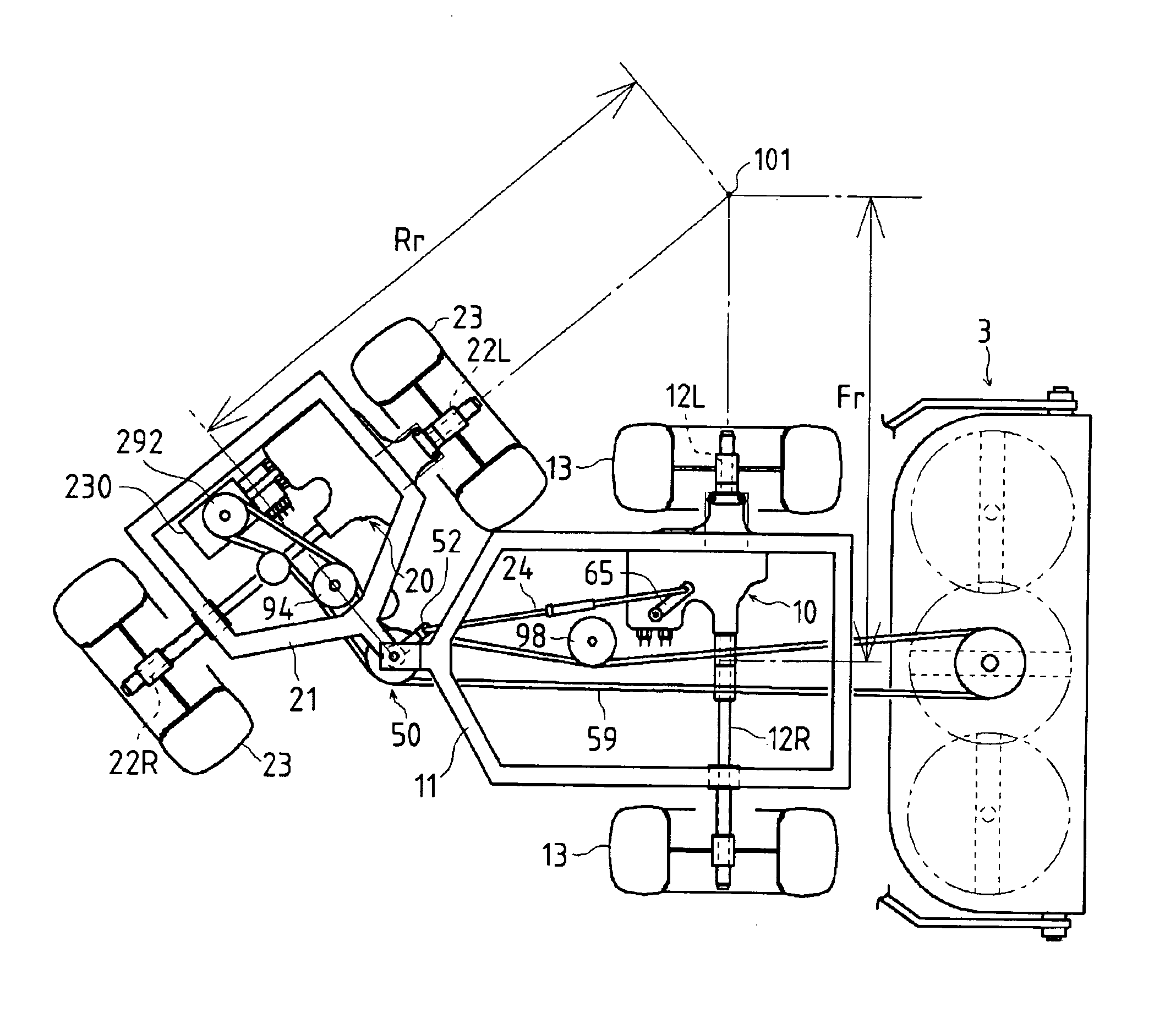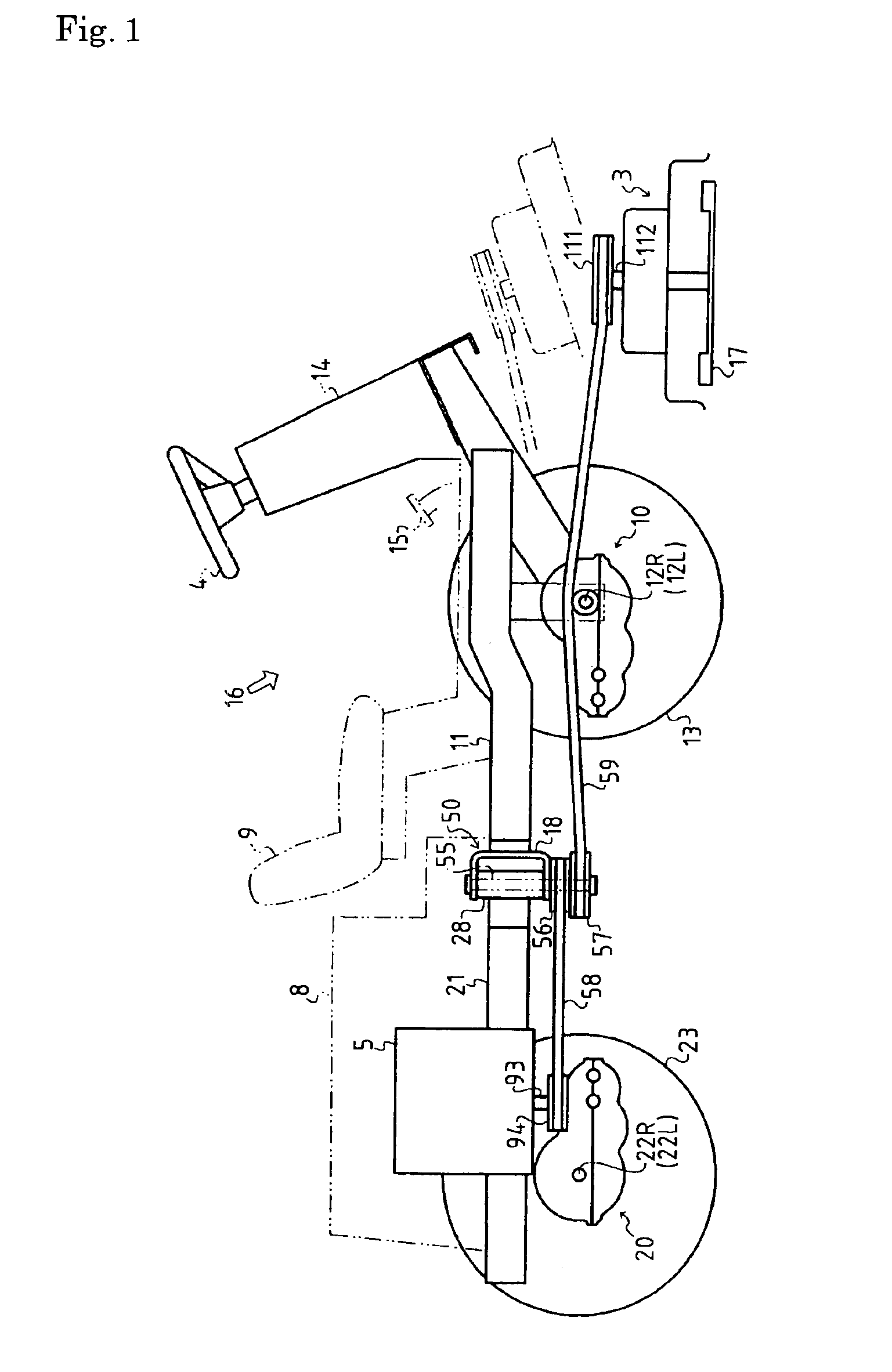Four wheel-drive vehicle
a four-wheel drive, vehicle technology, applied in the direction of trailer steering, fluid gearing, gearing, etc., can solve the problems of unable to use the power take-off shaft for driving the working device as a front-wheel drive shaft simply, lack of stability when working on slopes and road abilities, and difficulty in bailing out vehicles buried in mud or the like, etc., to achieve high flexibility of parts arrangement and save costs
- Summary
- Abstract
- Description
- Claims
- Application Information
AI Technical Summary
Benefits of technology
Problems solved by technology
Method used
Image
Examples
first embodiment
[0061]To begin with, description will be given of a structure of a riding lawn mower according to the present invention shown in FIGS. 1 to 9. FIG. 1 shows the riding lawn mower equipped at a front portion thereof with a mower device 3 serving as a working device. A front transaxle apparatus 10 is arranged on a front frame 11, and front wheels 13 are fixed to respective front wheel axles 12L and 12R extended laterally from the front transaxle apparatus 10. On the other hand, a rear transaxle apparatus 20 is arranged to a rear frame 21, and rear wheels 23 are fixed to respective rear wheel axles 22L and 22R extended laterally from the rear transaxle apparatus 20.
[0062]At a pivotal coupling part 50, a rear end part of the front frame 11 and a front end of the rear frame 12 are horizontally rotatably coupled to each other so that the rear frame 21 can be laterally folded relative to the front frame 11, thereby constituting an articulate vehicle serving as the riding lawn mower.
[0063]An...
second embodiment
[0134]Next, description will be given of a four-wheel-drive articulate working vehicle according to the present invention shown in FIGS. 12 to 22. FIGS. 12 and 13 show a working vehicle equipped at a front portion thereof with a mower device 3 serving as a working device. This vehicle has a front frame 11, which is longer than a rear frame 21 pivotally connected to the front frame 11. The front frame 11 is provided with a front transaxle apparatus 10 from which front wheel axles 12L and 12R (hereinafter, “a front wheel axle 12” is used as a generic name of the front wheel axles 12L and 12R) are extended in a transverse direction and fixed to respective front wheels 13. The rear frame 21 is provided with a rear transaxle apparatus 20 from which rear wheel axles 22L and 22R (hereinafter, “a rear wheel axle 22” is used as a generic name of the rear wheel axles 22L and 22R) are extended in a transverse direction and fixed to respected rear wheels 23.
[0135]A rear end portion of the front...
third embodiment
[0201]In the third embodiment, as shown in FIGS. 23 and 24, the coupling part 50 is provided with a stay 52a fixed to the pivotal connector 18 on the front frame 11 side, a link rod 24a is extended backward from a tip of the stay 52a, and connected to the motor control lever 65 of the rear transaxle apparatus 200, thereby being connected the movable swash plate 44 of the variable displacement hydraulic motor 40 in the rear transaxle apparatus 200. Namely, corresponding to the bending angle of the vehicle body, the rod 24a is moved so as to steplessly change the tilt angle of the movable swash plate 44 of the variable displacement hydraulic motor 40 in the rear transaxle apparatus 200, thereby changing the relative velocity between the front wheel axle 12 (axles 12L and 12R) and the rear wheel axle 22 (axles 22L and 22R).
[0202]However, in the third embodiment, since the variable displacement transaxle apparatus 40 is provided in the rear transaxle apparatus 200 on the rear frame 21 w...
PUM
 Login to View More
Login to View More Abstract
Description
Claims
Application Information
 Login to View More
Login to View More - R&D
- Intellectual Property
- Life Sciences
- Materials
- Tech Scout
- Unparalleled Data Quality
- Higher Quality Content
- 60% Fewer Hallucinations
Browse by: Latest US Patents, China's latest patents, Technical Efficacy Thesaurus, Application Domain, Technology Topic, Popular Technical Reports.
© 2025 PatSnap. All rights reserved.Legal|Privacy policy|Modern Slavery Act Transparency Statement|Sitemap|About US| Contact US: help@patsnap.com



